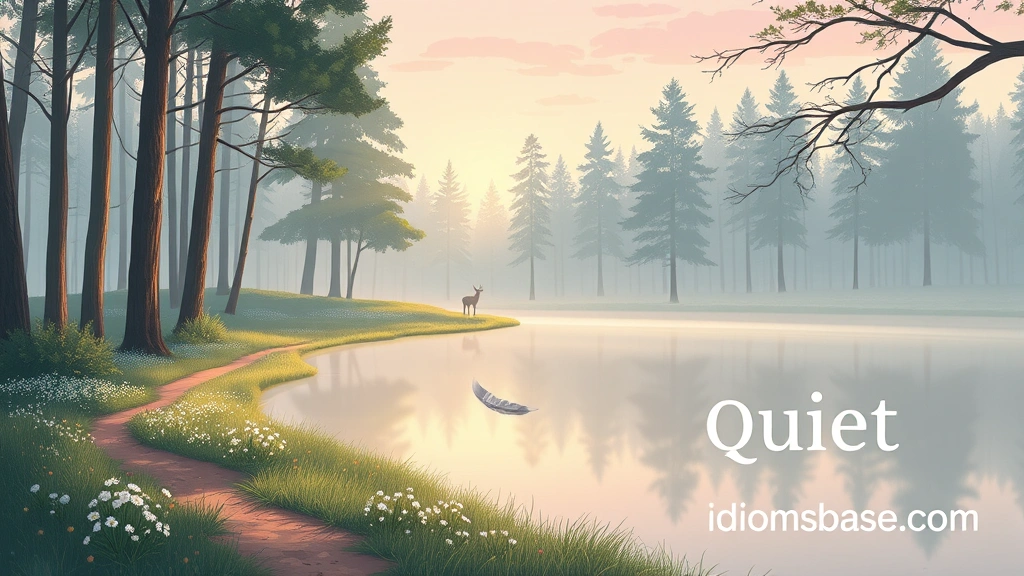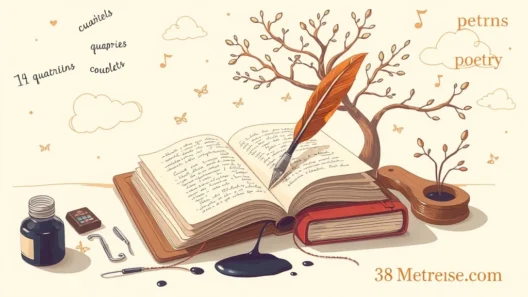Have you ever found yourself searching for just the right words to describe that profound sense of quiet? It's more than just the absence of noise, isn't it? Quiet can be a feeling, a presence, a state of mind, or even a tangible space. It's truly fascinating how we perceive and articulate silence in so many different ways!
As a writer, I've always been captivated by the power of language to transform abstract concepts into vivid imagery. That's why I'm so excited to share with you a collection of 38 incredible metaphors for quiet. Whether you're penning a novel, crafting a poem, or simply trying to express a moment of tranquility, these metaphors will help you paint a picture with words. Let's dive in and explore the beautiful world of quiet!
The Art of Describing Stillness
Before we jump into our list, let's briefly chat about why metaphors are so powerful. A metaphor is a figure of speech that directly compares two unlike things without using "like" or "as." It says one thing is another. This creates a powerful image in the reader's mind, making your writing more evocative and memorable. When we describe quiet using metaphors, we're giving it a personality, a texture, a form.
38 Metaphors for Quiet
Here are 38 unique and evocative metaphors for quiet, designed to inspire your creative spirit:
- Quiet as a blanket: Imagine a soft, warm blanket wrapping around you, muffling the world. It’s comforting and all-encompassing.
- Quiet as a whisper: So subtle, so gentle, almost imperceptible. It suggests a delicate, intimate silence.
- Quiet as a deep well: Profound, endless, and echoing nothing. This evokes a sense of vast, ancient stillness.
- Quiet as a closed book: Self-contained, holding its secrets, unread. It implies a private, undisturbed calm.
- Quiet as a sleeping cat: Soft, still, breathing almost imperceptibly. It’s a peaceful, contented quiet.
- Quiet as a forgotten room: Dusty, undisturbed, time standing still within its walls. This hints at a quiet that has been present for a long time.
- Quiet as a held breath: Tense, momentary, anticipation within the stillness. It’s a temporary, almost fragile quiet.
- Quiet as a still pond: Reflecting everything perfectly, no ripples, no disturbance. It represents clarity and calm.
- Quiet as velvet: Smooth, luxurious, absorbing sound. It’s a rich, soft, enveloping quiet.
- Quiet as a ghost: Present but unseen, felt but unheard. It suggests an ethereal, perhaps even eerie, silence.
- Quiet as a falling snowflake: Gentle, silent, each one adding to a growing hush. It evokes a delicate, accumulating quiet.
- Quiet as a shadow: Following, present, but making no sound. It’s a constant, unobtrusive quiet.
- Quiet as a secret: Hidden, unspoken, carefully guarded. It implies a deliberate, intimate silence.
- Quiet as a locked vault: Secure, impenetrable, holding everything within. It’s a deep, unbreachable quiet.
- Quiet as a painting: Frozen in time, beautiful, requiring no sound. It speaks of a visual, aesthetic stillness.
- Quiet as a dream: Illusive, personal, existing in its own silent world. It’s a subjective, internal quiet.
- Quiet as a deep forest: Ancient, vast, absorbing all sound. It’s a natural, profound silence.
- Quiet as a spider's web: Delicate, intricate, catching only the faintest vibrations. It’s a subtle, almost imperceptible quiet.
- Quiet as a forgotten melody: Lingering, but no longer played aloud. It’s a quiet that holds a memory of sound.
- Quiet as a vacuum: Empty, devoid of anything, including sound. It’s an absolute, total quiet.
- Quiet as a mime: Expressive without a single word or sound. It’s a quiet of deliberate communication.
- Quiet as the moon: Distant, luminous, observing silently. It’s a grand, cosmic quiet.
- Quiet as a calm sea: Vast, powerful, yet without a ripple. It’s a majestic, deep quiet.
- Quiet as a winter morning: Crisp, still, the world hushed under snow. It’s a fresh, bracing quiet.
- Quiet as a prayer: Reverent, personal, a space for reflection. It’s a spiritual, contemplative quiet.
- Quiet as a forgotten echo: Faded, almost gone, leaving only stillness. It’s a quiet that follows sound.
- Quiet as a velvet glove: Soft, conforming, muffling all contact. It’s a gentle, protective quiet.
- Quiet as a mime's smile: Expressive, yet utterly silent. It highlights the non-verbal nature of silence.
- Quiet as a blank canvas: Full of potential, waiting to be filled, but currently empty. It's a quiet of anticipation.
- Quiet as a hidden spring: Flowing unseen, its presence felt but not heard. It's a subtle, underlying quiet.
- Quiet as a sealed envelope: Containing messages, but holding them in silence. It's a quiet that holds information.
- Quiet as a fading photograph: Memories held, but the moment itself is still. It's a nostalgic, gentle quiet.
- Quiet as a sleeping volcano: Powerful, immense, but currently dormant. It's a quiet with underlying power.
- Quiet as a single tear: Profound, emotional, yet utterly silent. It's a quiet of deep feeling.
- Quiet as a spider's thread: Fine, almost invisible, yet strong. It's a subtle, persistent quiet.
- Quiet as a forgotten dream: Fading, elusive, existing only in memory. It's a quiet that's hard to grasp.
- Quiet as a velvet curtain: Absorbing sound, creating a private space. It's an intentional, muffling quiet.
- Quiet as a suspended moment: Time paused, everything held in perfect stillness. It's a quiet of timelessness.
Why Use Metaphors for Quiet?

Using metaphors isn't just about making your writing pretty; it's about making it resonate.
- Evokes Emotion: "Quiet as a sleeping cat" feels very different from "quiet as a locked vault." Each metaphor carries its own emotional weight.
- Adds Depth: Instead of just saying "it was quiet," you can convey what kind of quiet it was. Was it peaceful? Eerie? Profound?
- Enhances Imagery: Metaphors help your reader visualize the scene more vividly, drawing them deeper into your narrative.
- Shows, Don't Tell: This is a golden rule in writing, and metaphors are masters of it. Instead of telling the reader it was a peaceful quiet, you show them by describing it as "quiet as a still pond."
Key Takeaways
- Metaphors elevate your writing: They transform simple descriptions into vivid, memorable imagery.
- "Quiet" is multifaceted: There are countless ways to experience and describe quiet, each with its own nuance.
- Choose wisely: The best metaphor depends on the specific feeling or atmosphere you want to convey.
- Practice makes perfect: Experiment with different metaphors to find your unique voice.

Frequently Asked Questions (FAQ)
H4 What is a metaphor?
A metaphor is a figure of speech that directly compares two unlike things without using "like" or "as." It states that one thing is another, creating a powerful imaginative link. For example, "The world is a stage" is a metaphor.
H4 How do metaphors differ from similes?
The main difference is the use of "like" or "as." Similes use these words to make a comparison (e.g., "quiet as a mouse"), while metaphors state the comparison directly (e.g., "quiet is a blanket"). Metaphors are generally considered more forceful and direct.
H4 Why are metaphors important in writing?
Metaphors enrich language by adding depth, imagery, and emotional resonance. They help readers visualize concepts, understand complex ideas, and feel the mood or atmosphere you're trying to create. They make writing more engaging and memorable.

H4 Can I create my own metaphors for quiet?
Absolutely! The best metaphors often come from your own unique observations and experiences. Think about what quiet feels like to you, what it reminds you of, or what it does. Don't be afraid to experiment and be creative.
H4 How can I use these metaphors in my own writing?
Consider the specific context and the emotion you want to evoke. If you're describing a peaceful moment, "quiet as a sleeping cat" might be perfect. If you're describing an unsettling silence, "quiet as a ghost" could fit. Read your sentence aloud to see if the metaphor flows naturally and enhances your message.
H4 Are there any common pitfalls to avoid when using metaphors?
Yes, a few! Avoid mixed metaphors (combining two incompatible metaphors, like "pulling the rug out from under the apple cart"). Also, ensure your metaphor is clear and understandable; don't make it so abstract that your reader gets lost. Finally, don't overdo it – a few well-placed metaphors are more effective than too many.
H4 Can metaphors be used in everyday conversation?
Definitely! We use metaphors all the time without even realizing it. Phrases like "time is money," "my job is a jail," or "he's a walking encyclopedia" are all metaphors. Using them consciously can make your speech more vivid and expressive.
H4 How do metaphors contribute to SEO?
While metaphors don't directly impact SEO keywords in the same way, they contribute to high-quality, engaging content. Search engines prioritize content that keeps users on the page longer and provides value. Well-crafted metaphors make your content more readable, shareable, and enjoyable, which indirectly boosts your site's authority and ranking over time. They also provide semantic richness, helping search engines understand the broader context of your content.
Ready to Embrace the Quiet?
I hope this exploration of metaphors for quiet has sparked your imagination and given you new tools for your writing toolkit. The next time you encounter a moment of stillness, try to describe it using one of these metaphors, or even better, invent your own!
What's your favorite metaphor for quiet from this list? Or do you have a unique one of your own? Share your thoughts in the comments below – I'd love to hear from you! Let's celebrate the beautiful, profound, and often understated power of quiet together. Happy writing!






